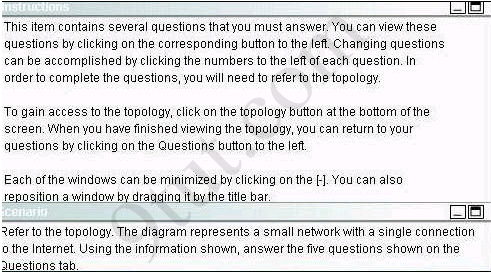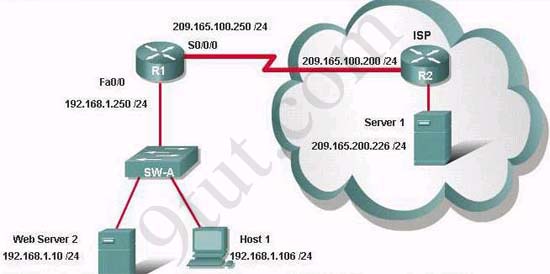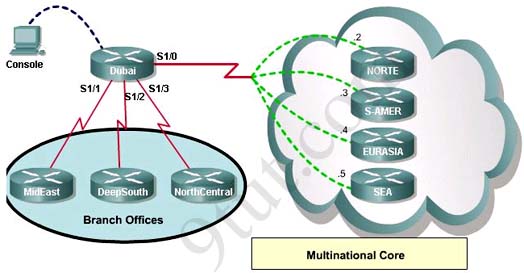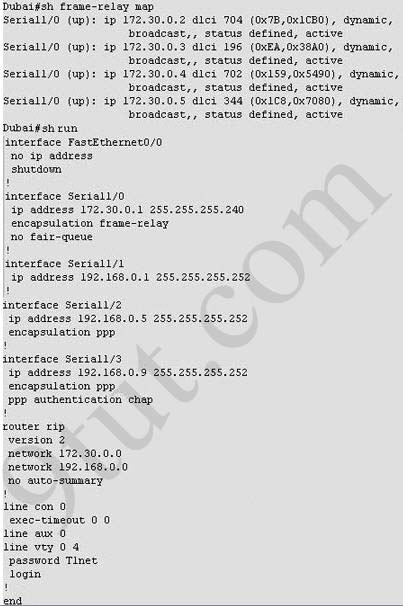CCNA – Hotspot
Here you will find answers to CCNA hotspot Questions
Hotspot Routing Question


Question 1:
If the router R1 has a packet with a destination address 192.168.1.255, what describes the operation of the network?
A – R1 will forward the packet out all interfaces
B – R1 will drop this packet because it is not a valid IP address
C – As R1 forwards the frame containing this packet, Sw-A will add 192.168.1.255 to its MAC table
D – R1 will encapsulate the packet in a frame with a destination MAC address of FF-FF-FF-FF-FF-FF
E – As R1 forwards the frame containing this packet, Sw-A will forward it ti the device assigned the IP address of 192.168.1.255
Answer: B
Question 2:
Users on the 192.168.1.0/24 network must access files located on the Server 1. What route could be configured on router R1 for file requests to reach the server?
A – ip route 0.0.0.0 0.0.0.0 s0/0/0
B – ip route 0.0.0.0 0.0.0.0 209.165.200.226
C – ip route 209.165.200.0 255.255.255.0 192.168.1.250
D – ip route 192.168.1.0 255.255.255.0 209.165.100.250
Answer: A
Quetion 3:
When a packet is sent from Host 1 to Server 1, in how many different frames will the packet be encapsulated as it is sent across the internetwork?
A – 0
B – 1
C – 2
D – 3
E – 4
Answer: C or D(depending on your understand, please read the comments to understand why)
Question 4:
What must be configured on the network in order for users on the Internet to view web pages located on Web Server 2?
A – On router R2,configure a default static route to the 192.168.1.0 network
B – On router r2, configure DNS to resolve the URL assigned to Web Server 2 to the 192.168.1.10 address
C – On router R1, configure NAT to translate an address on the 209.165.100.0/24 network to 192.168.1.10
D – On router R1, configure DHCP to assign a registered IP address on the 209.165.100.0/24 network to Web Server 2
Answer: C
Question 5:
The router address 192.168.1.250 is the default gateway for both the Web Server 2 and Host 1. What is the correct subnet mask for this network?
A – 255.255.255.0
B – 255.255.255.192
C – 255.255.255.250
D – 255.255.255.252
Answer: A
Hotspot Frame-relay Question


(In the old days, this question was a multi-choice question but Cisco upgraded it into a lab-sim question. Therefore, instead of listing all the configuration as above, you have to type show frame-relay map and show running-config to get its configuration)
Note: If you are not sure about Frame-Relay, please read my Frame Relay tutorial.
Question 1:
What destination Layer 2 address will be used in the frame header containing a packet for host 172.30.0.4?
A – 704
B – 196
C – 702
D – 344
Answer: C
Question 2:
A static map to the S-AMER location is required. Which command should be used to create this map?
A – frame-relay map ip 172.30.0.3 704 broadcast
B – frame-relay map ip 172.30.0.3 196 broadcast
C – frame-relay map ip 172.30.0.3 702 broadcast
D – frame-relay map ip 172.30.0.3 344 broadcast
Answer: B
Question 3:
Which connection uses the default encapsulation for serial interfaces on Cisco routers?
A – The serial connection to the MidEast branch office
B – The serial connection to the DeepSouth branch office
C – The serial connection to the NorthCentral branch office
D – The serial connection to the Multinational Core
Answer: A
Question 4:
If required, what password should be configured on the router in the MidEast branch office to allow a connection to be established with the Dubai router?
A – No password is required
B – Enable
C – Scr
D – Telnet
E – Console
Answer: A or D (because maybe there are 2 versions of this question, depending on the output of “show running-config” command, please read the explanation below)
Explanation
This question is not clear for a long time but now maybe the trick was solved. What Cisco wants to ask is the word used as password, not the type of connection, so in the exam you might see some strange words for answers like “En8ble”, “T1net”, “C0nsole”. All you have to do is to use the command “show running-config” as wx4 mentioned below to find the answer.
wx4 commented:
Q4: if password required which?
in my example it was connection to North!
How to figure out which pw is required?
#show running-config
1. check the interface to the router you need connection to. If there is “ppp authentication” you need a password!
2. you will find the password on the top of your running-config output
check the area:
username North password c0nsole
username xxxxx yyyyy
username…
in my case it was c0nsole, in your case it can be no password needed or a different password.
If you are still not clear, please read anton‘s comment:
A big question I noticed here was about the FR Lab regarding the password. You have to perform a show running-config and look for USERNAME and PASSWORD.
i.e.
username South_Router password c0nsol3
username North_Router password t31net
Obviously this has to be en PPP encapsulation, if asked for a posible password for SOUTH_ROUTER you pick c0nsol3, and for NORTH_ROUTER you pick t31net. If you’re running HDLC, i would pick “no password is required”.



Qusetion 4 is not clear…can any one describe what is the best answer A or D ..what is the diffrence between c0nsole & console…. enable & en8ble..what is T1net….
@mg
that’s just the text of the password
ccna exam in question where the What destination Layer 2 address will be used in the frame header containing a packet for host 172.30.0.4?
is supposed to do the assignments the command is (Show frame-relay map), but I make this command is not correct, and even when I put (show running-config) do not see the layer 2 protocol for each interface, and with (show interface) all appear with the HDLC protocol.
Why?
CCNA HERE I COME…
Q#4 What must be configured on the network in order for users on the Internet to view web pages located on Web Server 2?
A – On router R2,configure a default static route to the 192.168.1.0 network
B – On router r2, configure DNS to resolve the URL assigned to Web Server 2 to the 192.168.1.10 address
C – On router R1, configure NAT to translate an address on the 209.165.100.0/24 network to 192.168.1.10
D – On router R1, configure DHCP to assign a registered IP address on the 209.165.100.0/24 network to Web Server 2
Ans:C
What is the purpose of using the NAT on incoming packets or traffic???Can any one explain??
@cisco: Web server 2 has private IP address. But we cannot to use Private IP in the public network so we need some method to camouflage private IP. This method is NAT.
@Dims:thanks dude i’ve not abserved that??
9tut plz add a NAT and NAT overload(PAt)questions and tutorials
@Cicso craze
Foremst reason is privacy and security.
Secondly, public ip are not allowed in private ip areas.
Just like in certain high class society, one has to go through a check point before allowing an entrance. The “check point” is like “NAT”.
Public……check point(NAT)…….Private.
Excuse me for being so graphical.
@Cisco craze: You can read NAT & PAT tutorial here: http://www.9tut.com/network-address-translation-nat-tutorial
@xallax
Please, can you kindly give a breakdown on these two commands for me.
“ip route” and “default route” Where and when are they applicable. Thanks.
@anonymous
ip route – manually create a route towards a network. will have an administrative distance of 1 by default – can be any network
“default route” – default network – 0.0.0.0 0.0.0.0 – default place to send packets if the destination network is unknown to the router
Q2 above.
Users on the 192.168.1.0/24 network must access files located on the Server 1. What route could be configured on router R1 for file requests to reach the server?
The answer to this is : ip route 0.0.0.0 0.0.0.0 s0/0/0 according to your explanation shouldn’t it be: default route 0.0.0.0 0.0.0.0 s0/0/0 (Does these two commands basically do the same thing)
Is kinda confusing. Can you give a breakdown. Thanks.
@Anonymous
There is no command on the global conf mode that is “RouterC(config)#default route ?
% Unrecognized command ……” maybe i have a different ios version.
There is such a command as “RouterC(config)#ip route ?” and also “RouterC(config)#ip default-network ?”
so may be its a trick question to see if you know your routing commands
The question above titled “Hotspot Frame-relay Question” was on the ICND2 exam today.
Obviously this has to be en PPP encapsulation, if asked for a posible password for SOUTH_ROUTER you pick c0nsol3, and for NORTH_ROUTER you pick t31net. If you’re running HDLC, i would pick “no password is required”.
then what we choose if its c0nsol3 we choose E-Console .. bcz e replaces with 3 .. what we choose ??
Hi guys i m giving CCNA exm in 2 weeks. can any1 forward me dumps to jarjishussain@yahoo.com
thanks
Hot Spot Routing Question 1: 192.168.1.255 is a “directed broadcast ” address. For mask /24 means that router will check and match the first three octets in the routing table and route packet to network 192.168.1.0 /24 . Then in layer 2, it will change it to “local broadcast” which is FF-FF-FF-FF-FF-FF to broadcast in the local broadcast domain. I think the better answer should be “D”.
If the packet address is 255.255.255.255, then router will drop it.
Hello everyone,
Can anyone kindly send me the latest dumps for CCNA640-802
This would surely be a great favour.
Thanks in advance.
Hot Spot Routing Question 1: 192.168.1.255 is a “directed broadcast ” address. For mask /24 means that router will check and match the first three octets in the routing table and route packet to network 192.168.1.0 /24 . Then in layer 2, it will change it to “local broadcast” which is FF-FF-FF-FF-FF-FF to broadcast in the local broadcast domain. I think the better answer should be “D”.
If the packet address is 255.255.255.255, then router will drop it.
I agree with this statement…. Any one else have thoughts on this….
Please…do SIM come during the normal questions or at the end of the normal question or it is a different question on its own….someone pls help me,I am writing my exam tomorrow…thanks
@ cisco student, from my own point of view,the router won’t forward the packet with destination of 192.168.1.255. The router knows its network and understands definately that,that’s a broadcast address for that segment.since it as a mask of /24. NB: routers don’t forward broadcast by default…..
@3o3o: Sims are independent questions. They appear randomly in the exam (so you may see it at the beginning, in the middle or at the end of your exam).
Hi All,
my humble contribution to answer the Hotspot – routing Directed Broadcast Question mistery
(not CCNA, but I will try it on the Oct 29th)
from the net:
http://www.certforums.co.uk/forums/general-cisco-certifications/16819-ip-directed-broadcast.html
….”directed-broadcasts are generally a bad thing, and are disabled by default on all interfaces in Cisco IOS.
A directed-broadcast is an ip packet with a destination address that is a valid broadcast address for a subnet, ….but does not originate from that subnet.
It is trivial to abuse directed-broadcasts for smurf or fraggle attacks and so directed-broadcasts should always be disabled (the default) unless there is a need for them. In a properly designed network I can’t think of a need for directed-broadcasts. If you needed to use them, an acl can be configured to limit malicious use of directed-broadcasts.
An example of a directed-broadcast would be a packet sent to a router interface e1 addressed to the broadcast address of the subnet on interface e2. The router will then helpfully direct the packet out e2 and “explode” the broadcast on the subnet. It is easy to see how an attacker could exploit this, hence no ip directed-broadcast is the default.”
….
and in addition:
ip directed broadcast
According to cisco press 642-812:
“the no ip directed-broadcast command configures the router or switch to prevent the translation of a directed broadcast to a physical broadcast”.
Conclusion:
Correct answer is B – because
1. packet has originated from the same LAN. If it was from another LAN on the same Router it would be translated to al “Fs” Layer 2 broadcast,
2. the option that packet has arrived from the Internet is not valid because of the NAT.
This eliminates all options and just B stays valid – I would say.
Thanks 9tut
Hotspot – routing,
The answer on Q3 – how many times frame header is gonna be changed is 3.
Or, that is “what cisco guys would rather like to hear” here; and, as per cisco academy curriculum…in addition, all Layer 2 encapsulation is frame – like one, and defined by Data link layer protocols.
thanks
Reply to Hot Spot Routing Question 1:
Correct answer cannot be B
B – R1 will drop this packet because it is not a valid IP address
It is because 192.168.1.255 /24 is a directed broadcast address and it is a ” valid ” IP address. As far as the routing goes, if the route existed in R1 routing table, R1 will check the destination address and compare to subnet mask for longest match. In other words, router use network addresses for routing, host portion is not important until the PDU pushed down to Layer 2, then host address must be able to translate to mac address.
/24 = 255.255.255.0 means that the first 24 bits must matched, and the last 8 bits, it doesn’t matter, and any last 8 bit values will change to zeros in route determination. (hardware-wise: host portion logic ANDed with Zero portion of mask, the result is always zero)
So for the destination address is 192.168.1.1 or 192.168.1.100, or 192.168.1.255, R1 will ignore the host portion and change the address to the network address 192.168.1.0 and forward the packet to the destination network which is fa0/0 interface according to the routing table.
For switch SW-A, the host address 192.168.1.255, will translate to local broadcast destination mac address FF-FF-FF-FF-FF-FF to flood all ports except the port where the frame came from.
Yes, It would be translated to FFs but only if it came from another LAN on the same router(by definition of directed broadcast);
but there is not another LAN as they said “small network”, and Routers do discard broadcast, which is the one of their main functionality. Nor routing protocol is needed or configured (single LAN).
Another network attached, is the WAN, and NAT” is” implemented what we know from the next question.
This is a typical Cisco Academy question, tricky and unpleasant.
Hello,
I tried to set up a Packet Tracer for the LAN part. There is no ip directed broadcast in Router R1. I ping 192.168.1.255 in Router R1 CLI, Router R1 send out echo requests to all hosts and all hosts reply. It seems the Router R1 didn’t drop the directed broadcast packet. The following is from the PT R1 CLI output after PING.
R1#ping 192.168.1.255
Type escape sequence to abort.
Sending 5, 100-byte ICMP Echos to 192.168.1.255, timeout is 2 seconds:
Reply to request 0 from 192.168.1.10, 39 ms
Reply to request 0 from 192.168.1.106, 78 ms
Reply to request 1 from 192.168.1.10, 6 ms
Reply to request 1 from 192.168.1.106, 13 ms
Reply to request 2 from 192.168.1.10, 11 ms
Reply to request 2 from 192.168.1.106, 11 ms
Reply to request 3 from 192.168.1.10, 6 ms
Reply to request 3 from 192.168.1.106, 13 ms
Reply to request 4 from 192.168.1.10, 4 ms
Reply to request 4 from 192.168.1.106, 12 ms
@Packet Tracer:
An IP directed broadcast is an IP packet whose destination address is a valid broadcast address for some IP subnet, but which originates from a node that is not itself part of that destination subnet. (from cisco.com)
I think in your case router R1 has interface in the same subnet.
Try to ping from a host in the another subnet.
Can someone please email me the latest CCNA dumps. I will be taking the exam in 1 week.
I give my thank to all in advance for whomever is willing to help.
email: litsios_nikos@yahoo.gr
Thanks
@olo
default router always work in a stub networks e.g router towards internet. Default route it actually routes you to the network that is not listed in your ROUTING TABLE… Example
R1(config)#ip route 0.0.0.0 0.0.0.0 192.168.1.2 or 0.0.0.0 this means please route me t oany 0.0.0.0 => network 0.0.0.0 => to any subnetmask with an administrative distance ( interface of the router or ad )to get to that netwok is 192.168.1.2…. but in this case since R1 is the stub router you can place the admin distance to its interface (s0/0) eg. ip route 0.0.0.0 0.0.0.0 s0/0.. Hope that helps….. :)
For more info regarding Default route:
http://www.cisco.com/en/US/docs/security/asa/…/route_static.html
is there a SIM for this hotspot ?
Can someone please email me the latest CCNA dumps. I will be taking the exam in a couple of weeks.
Thank you much
email: akilimak@yahoo.com
Thanks,
-Reg
Routing Q1. Answer is B, as stated…Why?
P.185 of Exploration Network Fundamentals says this…
‘Although routers do not forward directed broadcasts by default, they can be configured to do so.’
Also Q3. Answer is D. 3 different frames form Host1 to Server1 as explained by xallax. There’s 2 different ‘frame types’, but question asks how many different frames, not frame types.
Great site by the way!!
i m not able to understand Q3 can anybody explain?
@vikas
1 frame from Host 1 to R1
1 frame from R1 to R2
1 frame from R2 to Server 1
i’m counting 3 frames.
@ Xallax
i’m countin’ 2 frames only !!
the Q said different frames got that .
Hi..
Can anyone please send me leasted dumps.. I have exam on 28 Nov .. shaik882@gmail.com
Thanks in advance
Sheikh
Hi..
Can anyone please send me leasted dumps.. I have exam on 28 Nov .. fsetulbal@gmail.com
Thanks in advance
OK, I see a variation of this on ICND2 that asks me for a default gateway of a host on one of the networks. I keep missing it, anybody else seen this???????
@xallax
thanks for your reply
But i hav a doubt in Q3 of hot spot relay.
plz reply asap.
@vikas
goes from Host1 to R1′s F0/0 interface
goes from R1′s S0/0/0 interface to R2′s WAN interface
goes from R2′s interface to the server
i’m counting 3 times
@ xallax
please read my comment i want explanation to question 3 of HOTSPOT FRAME-RELAY
@vikas
my bad, im only human :)
look at the output of the running-config
fa0/0
is using default enc
s1/0
is using frame-relay
s1/1
is using default
s1/2
is using ppp
s1/3
is using ppp with chap
now look at the image with all the routers.
s1/0 goes to the multinational core
s1/1 goes to the mideast router
s1/2 goes to the deepsouth router
s1/3 goes to the northcentral router
we’re interested in s1/1 because it’s the only serial connection that is using the default encapsulation (cisco). it is connected to the mideast router.
answer A is correct
@ xallax
thats was really informative and hidden one ..
thanks for sharing.
Hi Xallax
But in the given Diagram, there are no sx/y interface but there are x/y/z interface. I didn’t get ur Story of Encapsulation. Can u please elobrate it again
Regards
FAISAL
@faisal
which diagram? first one or second one?
Good and nothing
Good Morning to all a very thing i want to need is eigrp and acl that needs to be done immediately.
please make sure these are done immediately
Acl and cisco backup for the devices blockup in the router